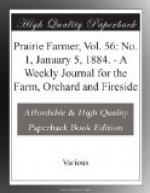ANSWER.—The Japan persimmon, Diospyros kaki, is, as we understand it, an evergreen of sub-tropical origin, and will not be likely to fruit satisfactorily far north of the region of the orange. Like the fig, in your latitude, it may stand what frosts you have and, like it, attain considerable growth, but you will seldom get a crop. We know enterprising nurserymen are telling us it will grow and fruit as far north as Washington; but we were told the same story about the eucalyptus, which proved to be no more hardy than the orange. Our authorities for these opinions may be regarded as first-class—no less than LeBon Jardinier, who says it can not be grown and successfully fruited outside the region of the orange. Recently, at a horticultural exhibition at Nice, France, there was a fine show of the kakis contributed by a gardener in the vicinity of Toulon, of which the official report gives this account: “Among the newer exotics were the kakis, of Japan, grown at Toulon. The fruit is about the size of an average apple, a bright, orange-red in color, and the tree is very productive. The Japanese make a great account of it, both as a fruit, when ripe, and as a source for obtaining tannin, in its green state. It appears to accommodate itself remarkably well to the climate of Provence, and especially merits to be introduced into Algeria, where it will even do better in all reasonable probability.”. In respect to the appearance of the fruit, it more nearly resembles in shape and size a bell pepper, than an apple, but the color is orange-red, as described. It is pretty sure to cut a great figure among the fruit products of Florida, where its successful cultivation will lend additional attractions to that already seductive State.
MRS. SARAH Y. STAPLES, DALLAS, TEXAS.—I do not ask you for a remedy for the roup, with which my fowls have been recently affected; but for a course of treatment to follow to prevent its return?
ANSWER—The roup may be brought upon healthy fowls if they are shut up in narrow and unventilated quarters at night, and of days turned out in cold or wet weather. And it will almost certainly follow if they are confined under glass, as they sometimes are in winter, in abandoned green-houses. In the first place, see fowls have a dry and airy roosting place, but where they will be out of a draft or cold currents. Feed once daily in the morning, the following compounded rations. Raw onions one part, pork-cracklins one part, and bread or boiled potatoes one part, chopped tolerably fine, but do not wet the mixture before feeding. If you can substitute a few bits of garlic for twice the measure of onions, it will be all the better for the health of the fowls, but they might taint the taste of the eggs. If fowls are fed this mixture once daily, it don’t matter much what the other food is, whether corn or small grain, though for laying mill-screenings or shrunken wheat is best.
ASA GRAY, ROCKFORD, ILL.—I have seen it stated the daily rations of the cowboys of the Southwest, in certain sections and during some months, was confined to raw beef, rock salt, and red peppers. How is it?




